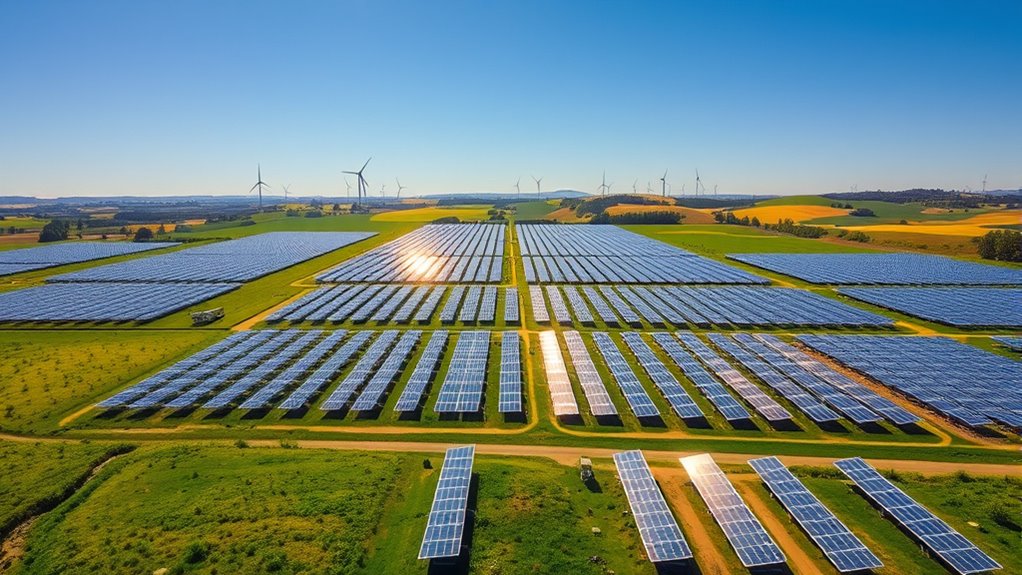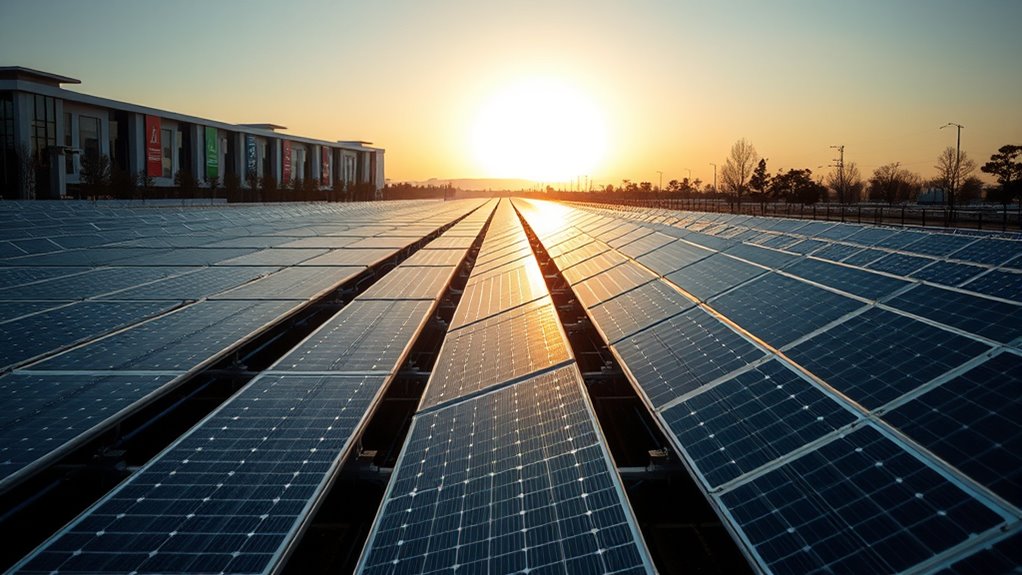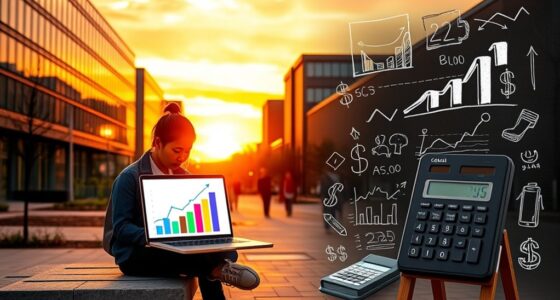Investing in solar panels in 2025 is a smart choice as costs continue to drop, and technology improves efficiency. You can expect a payback period of around 8-9 years, with potential savings over $57,000 over time. Plus, durable panels offer long-term environmental and financial benefits. Government incentives and regional policies can boost your return. If you want to see how these factors make solar a worthwhile investment, there’s more to explore.
Key Takeaways
- Reduced installation costs and technological advances make solar panels more affordable and efficient by 2025.
- Long-term savings, with payback periods around 8-9 years, justify the investment.
- Durability and improved efficiency modules ensure sustained performance over 25-30 years.
- Government incentives and favorable policies enhance financial returns and accessibility.
- Growing market and innovations support ongoing environmental benefits and energy independence.
Financial Benefits of Installing Solar Panels in 2025

Are you wondering if installing solar panels in 2025 is a smart financial move? The answer depends on factors like solar panel durability and installation costs. Modern solar panels are built to last 25-30 years, meaning your investment can pay off over decades. Installation costs have continued to decline due to technological advances and increased competition, making solar more affordable. With payback periods typically around 8 to 9 years, you’ll start saving money quickly. Over time, these savings can reach $57,000 or more for the average homeowner, thanks to reduced utility bills and incentives. Plus, durable panels ensure consistent performance, maximizing your long-term financial benefits while protecting you against rising energy prices. Additionally, sound recording techniques can help optimize the setup of your solar energy system for better efficiency.
Current Trends and Growth in the U.S. Solar Market

The U.S. solar market continues to expand rapidly, driven by declining costs, technological improvements, and strong policy support. As more homeowners adopt solar, you’ll notice trends like increasing system sizes and improved solar panel aesthetics that blend better with rooftops. However, installation challenges persist, including permitting delays and logistical issues that can affect project timelines. Despite these hurdles, industry confidence remains high, with about 78% of installers planning to boost sales in 2025. Here’s a snapshot of current trends:
| Trend | Impact | Challenges |
|---|---|---|
| Growing capacity | More homes equipped | Permitting delays |
| Improved aesthetics | Better integration | Installation challenges |
| Policy incentives | Increased affordability | Regulatory variability |
| Market expansion | Broader access | Supply chain disruptions |
| Technological advances | Higher efficiency | Cost fluctuations |
Additionally, equipment compatibility plays a critical role in ensuring optimal performance and longevity of solar installations.
Environmental Impact and Sustainability Advantages

By installing solar panels, you considerably cut your household’s carbon footprint and help combat climate change. You also gain greater energy independence, reducing reliance on fossil fuels and utility fluctuations. These environmental benefits support broader sustainability goals while protecting your energy future. Additionally, adopting renewable energy sources like solar aligns with global efforts to promote environmental sustainability and reduce environmental impact.
Significant Carbon Footprint Reduction
Switching to solar power substantially reduces your household’s carbon footprint, making a meaningful contribution to combating climate change. By harnessing clean, renewable energy, you decrease reliance on fossil fuels and lower greenhouse gas emissions. Solar panel aesthetics have improved, allowing your system to blend seamlessly with your home’s design, while installation logistics are now more streamlined, minimizing disruptions. Every kilowatt-hour generated by your solar system displaces electricity from carbon-intensive sources, preventing over 100,000 pounds of CO2 emissions over its lifetime. This shift supports broader sustainability goals and helps protect the environment for future generations. Additionally, advancements in sound design tools and techniques can optimize the monitoring and efficiency of your solar system’s performance. Your decision to invest in solar not only benefits your wallet but also promotes a cleaner, greener planet by considerably reducing your household’s environmental impact.
Enhanced Energy Independence
Investing in solar panels considerably enhances your household’s energy independence, reducing reliance on the utility grid and fossil fuels. The installation process is straightforward, often completed within a day or two, and can be tailored to your home’s roof, considering solar panel aesthetics to blend seamlessly with your property. By generating your own power, you’ll protect yourself against utility rate hikes and outages, especially when combined with battery storage. This independence not only benefits the environment but also provides peace of mind, knowing you’re less affected by external energy fluctuations. As technology advances, solar panels become more efficient and visually appealing, making it easier to integrate sustainable energy solutions into your home without compromising style or functionality. Additionally, low light office plants can complement your indoor environment, creating a more sustainable and healthy living space.
Support for Climate Goals
Switching to solar energy markedly advances your contribution to global climate efforts. Solar panels are built to last, with high durability that guarantees long-term environmental benefits. Their robust design reduces the need for frequent replacements, minimizing waste and conserving resources. Although installation costs can seem high initially, the environmental impact of reducing fossil fuel reliance outweighs these expenses. Solar panels generate clean energy, considerably lowering carbon emissions and helping meet climate goals. By choosing reliable, durable systems, you support sustainability efforts while enjoying ongoing energy savings. The durability of solar panels ensures they remain effective over decades, maximizing their positive impact on the environment. Additionally, dog names can be a fun way to personalize your solar energy journey, making the switch more engaging for the whole family. Ultimately, investing in solar aligns your energy use with broader environmental priorities, making it a responsible choice for the planet’s future.
Global Investment Patterns and Market Dynamics

Global investment patterns in renewable energy, especially solar, are experiencing notable shifts in 2025. You’ll notice changes driven by fluctuating global supply chains, which impact the availability and cost of solar components. Market competition is intensifying as more countries and companies seek to capitalize on the sector’s growth, prompting innovation and price reductions. While overall global renewable investments grew about 10%, U.S. investments declined due to policy uncertainties, whereas Europe and China increased their funding, shifting the geographic focus. These dynamics influence project feasibility and costs, making solar more accessible in some regions while challenging in others. Staying aware of these patterns helps you better understand the investment climate and potential risks or opportunities in solar energy for your needs.
Technological Innovations Enhancing Solar Efficiency

Advances in solar technology are driving significant improvements in system performance and cost-effectiveness. You’ll benefit from innovations like enhanced solar panel durability, which extends lifespan and reduces maintenance costs. Inverter advancements now allow for higher efficiency, better grid integration, and improved energy conversion rates. These developments contribute to more reliable and powerful solar systems. Key innovations include:
- Improved materials increasing solar panel lifespan and resistance to environmental stress
- Higher efficiency modules capturing more sunlight per square foot
- Smart inverters optimizing power output and managing grid interactions
- Modular designs allowing scalable, customizable systems
- Better cooling techniques reducing performance loss in hot climates
A notable benefit of these technological improvements is the increased resilience of solar panels against extreme weather conditions, ensuring consistent energy production over time.
Regional Factors Affecting Solar Investment Returns

Your solar investment’s success heavily depends on regional factors like local electricity rates, government incentives, and policies. These regional policy variations influence payback periods, overall savings, and system viability. Higher electricity rates, for example, can considerably improve your ROI by increasing utility cost avoidance. Local policies on net metering or permitting also impact installation costs and timeframe. Additionally, understanding expert advice can help you make more informed decisions about your solar investments.
Policy Incentives and Regulatory Influences

Policy incentives are fueling solar market growth, making installations more attractive and financially viable for many homeowners. However, regulatory environments vary across states and countries, directly impacting the speed and ease of adopting solar technology. Understanding these influences helps you navigate how policy changes can either accelerate or hinder your solar investment in 2025. Additionally, staying informed about deep-sky imaging techniques can inspire innovative ways to visualize and appreciate the universe beyond terrestrial concerns.
Policy Incentives Drive Growth
Government incentives and supportive regulations are key drivers of solar growth in 2025. These policies lower installation costs and improve solar panel durability, making solar more accessible and reliable. They encourage homeowners and businesses to invest in solar energy by offering tax credits, rebates, and favorable net metering policies.
Here’s how policy incentives boost solar adoption:
- Reduce upfront installation costs, making projects more affordable
- Promote technological advancements by supporting research and development
- Extend warranties and durability standards for solar panels
- Simplify permitting processes to speed up installations
- Increase access for underserved communities through targeted programs
These measures create a stable environment for solar investments, ensuring long-term savings and resilience against market fluctuations. You benefit from lower costs and more durable solar solutions that stand the test of time.
Regulatory Environment Impact
Regulatory environment substantially shapes the growth and viability of solar energy in 2025 by influencing installation costs, market access, and technological advancements. Policy shifts can accelerate adoption through incentives, but regulatory hurdles may slow progress by adding complexity or delays. Staying informed about changing policies helps you maximize benefits and avoid unnecessary costs. Additionally, understanding the potential pitfalls in adopting new payment technologies can be crucial when financing solar projects.
Long-Term Outlook for Solar Energy Adoption

Looking ahead, the long-term adoption of solar energy appears highly promising due to ongoing technological innovations, falling costs, and increasing environmental awareness. As solar panels become more integrated into everyday life, their aesthetics improve, making them less obtrusive on rooftops. You’ll also see fewer installation challenges as new techniques streamline setup and reduce costs. The industry’s growth suggests wider accessibility and stronger incentives for homeowners.
- Improved solar panel aesthetics blend seamlessly with building designs
- Advanced installation methods minimize challenges and costs
- Increased energy independence through expanded battery storage options
- Growing consumer awareness boosts demand for sustainable solutions
- Policy support and incentives encourage widespread adoption
Frequently Asked Questions
How Do Local Utility Policies Impact Solar Investment Payback in 2025?
Utility policies and regulation impacts directly influence your solar investment payback in 2025. Favorable net metering and incentive policies can shorten your payback period by increasing your energy savings. Conversely, restrictive regulations or reduced incentives can extend payback, making solar less financially attractive. Staying informed about local utility policies helps you optimize your system’s financial benefits, ensuring you maximize savings and return on investment over its lifetime.
What Are the Risks of Supply Chain Disruptions Affecting Solar Panel Costs?
Supply chain delays and raw material shortages can considerably increase solar panel costs in 2025. When these disruptions occur, you might face longer wait times for equipment, higher prices, or limited availability of key components like silicon or inverter parts. These risks can reduce your savings and extend payback periods, making your investment less predictable. Staying informed about supply chain developments and choosing reputable suppliers can help mitigate these potential issues.
How Does Battery Storage Integration Influence Overall Solar Investment Value?
You should know that integrating battery storage can boost your solar investment value considerably, especially with an average storage capacity of around 10 kWh that can cover your energy needs during outages. Battery longevity, typically 10-15 years, ensures long-term reliability. This setup reduces utility reliance, maximizes savings, and enhances energy independence, making your system more resilient and cost-effective over its lifespan, especially as utility rates continue to rise.
Are There Specific Incentives for Low-Income Households to Adopt Solar in 2025?
Yes, in 2025, you can benefit from specific incentives designed to improve solar affordability for low-income households. Community programs and federal initiatives, like expanded tax credits and targeted grants, make solar more accessible and affordable. These programs help reduce upfront costs, allowing more families to adopt solar energy, lower their utility bills, and contribute to environmental sustainability. Check local policies to find out which incentives apply to your area.
What Is the Expected Lifespan and Maintenance Cost of Solar Panels in 2025?
Think of your solar panels as reliable old friends that stick around for decades. In 2025, they typically last 25-30 years, with minimal panel degradation—usually about 0.5% annually. Maintenance costs are like tending a garden—rarely needed beyond regular checks. Most come with warranty coverage that protects you from unexpected issues, ensuring your investment keeps shining bright without draining your wallet over time.
Conclusion
By investing in solar panels in 2025, you can boost your savings, support sustainability, and embrace innovation. You can benefit from evolving policies, capitalize on technological advancements, and enjoy regional incentives. You can reduce your carbon footprint, increase your energy independence, and secure long-term returns. Ultimately, you can make a smart investment, make a positive impact, and pave the way for a greener future. The choice is clear—solar panels are worth considering this year.










